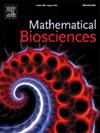A new optimized regularized Stokeslet model reveals the effects of multicellular protozoan colony configuration on hydrodynamic performance
IF 1.8
4区 数学
Q2 BIOLOGY
引用次数: 0
Abstract
Many microbial eukaryotes have unicellular life stages, but can also form multicellular colonies. We explored hydrodynamic consequences of colony morphology, which affects swimming and flux of prey-carrying water to cells in a colony, using the choanoflagellate, Choanoeca flexa, which forms cup-like colonies that can turn inside-out so flagella line the cup’s interior or cover its outside surface. Detailed hydrodynamic models incorporating cell morphologies are not feasible for colonies with many cells. Therefore, we designed a reduced model of each cell using regularized-force-dipoles with parameters optimized (by selecting the regularized delta function from a given class) to match the flow-field of a detailed model of a cell. Calculated swimming speeds and water flux to flagella-in colonies match those measured for living C. flexa. For a given shape (flat bowls, hemispheres, spherical cups) of flagella-in colony, models showed that swimming speed and water flux towards the colony increases with cell density, although flux per cell is independent of density. Denser packing of cells at the front of flagella-in colonies increases swimming speed and flux to cells at all positions in the colonies. Flagella-in colonies swim more slowly, but produce higher water flux per cell than do flagella-out colonies of the same configuration, suggesting that flagella-out colonies are better swimmers, whereas flagella-in colonies are better feeders. A model flagella-out colony with morphology matched to a real C. flexa requires a flagellar force 5–10 times greater than that for flagella-in colonies to achieve the measured swimming speed, suggesting flagella beat differently on flagella-out colonies.
一个新的优化正则化Stokeslet模型揭示了多细胞原生动物群落结构对水动力性能的影响。
许多真核微生物具有单细胞生命阶段,但也可以形成多细胞菌落。我们探索了菌落形态的流体动力学结果,它影响游泳和携带猎物的水到菌落细胞的通量,使用Choanoeca flexa, Choanoeca flexa形成杯状菌落,可以从内到外翻转,因此鞭毛排列在杯子的内部或覆盖其外部表面。包含细胞形态的详细流体动力学模型对于具有许多细胞的菌落是不可行的。因此,我们使用正则化力偶极子设计了每个细胞的简化模型,并优化了参数(通过从给定类中选择正则化δ函数),以匹配细胞详细模型的流场。计算出的游动速度和到达鞭毛群的水流通量与活的弯曲梭菌的测量结果相符。对于给定形状(扁平碗状、半球形、球形杯状)的鞭毛群体,模型显示,游动速度和流向群体的水通量随着细胞密度的增加而增加,尽管每个细胞的通量与密度无关。鞭毛集落前部细胞的密集堆积增加了游动速度和集落中所有位置细胞的通量。在相同的结构下,鞭毛内的菌落比鞭毛外的菌落游得更慢,但每个细胞产生更高的水通量,这表明鞭毛外的菌落是更好的游泳者,而鞭毛内的菌落是更好的捕食者。一个形态与真实弯弯菌相匹配的模型鞭毛群需要比鞭毛群大5-10倍的鞭毛力才能达到测量的游动速度,这表明鞭毛在鞭毛群上的跳动不同。
本文章由计算机程序翻译,如有差异,请以英文原文为准。
求助全文
约1分钟内获得全文
求助全文
来源期刊

Mathematical Biosciences
生物-生物学
CiteScore
7.50
自引率
2.30%
发文量
67
审稿时长
18 days
期刊介绍:
Mathematical Biosciences publishes work providing new concepts or new understanding of biological systems using mathematical models, or methodological articles likely to find application to multiple biological systems. Papers are expected to present a major research finding of broad significance for the biological sciences, or mathematical biology. Mathematical Biosciences welcomes original research articles, letters, reviews and perspectives.
 求助内容:
求助内容: 应助结果提醒方式:
应助结果提醒方式:


